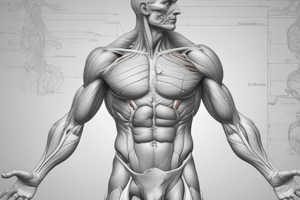Podcast
Questions and Answers
What are abductors?
What are abductors?
- Muscles that draw a body part toward the midline
- Muscles that draw a body part away from the midline (correct)
- Muscles located in the heart
- Muscles that assist in digestion
What is the primary function of adductors?
What is the primary function of adductors?
- Affect nerve impulses
- Draw body parts away from the midline
- Draw body parts toward the midline (correct)
- Facilitate the movement of blood
What is defecation?
What is defecation?
Elimination of foods from the body
What is the deltoid muscle responsible for?
What is the deltoid muscle responsible for?
Define digestion.
Define digestion.
What are endocrine glands?
What are endocrine glands?
What do exocrine glands produce?
What do exocrine glands produce?
What is the function of the heart?
What is the function of the heart?
What is ingestion?
What is ingestion?
What defines a joint?
What defines a joint?
What is the latissimus dorsi?
What is the latissimus dorsi?
Define lymph.
Define lymph.
What are maxillary bones?
What are maxillary bones?
What is metabolism?
What is metabolism?
What do nasal bones form?
What do nasal bones form?
What are nerves made of?
What are nerves made of?
What are palatine bones?
What are palatine bones?
What is the role of pectoralis major and minor?
What is the role of pectoralis major and minor?
What is pulmonary circulation?
What is pulmonary circulation?
What is a reflex?
What is a reflex?
What is the serratus anterior muscle's function?
What is the serratus anterior muscle's function?
Define systemic circulation.
Define systemic circulation.
What is the trapezius muscle responsible for?
What is the trapezius muscle responsible for?
What are turbinal bones?
What are turbinal bones?
What is the vomer bone?
What is the vomer bone?
What are zygomatic bones also known as?
What are zygomatic bones also known as?
What is anatomy?
What is anatomy?
Define physiology.
Define physiology.
What is histology?
What is histology?
Study Notes
Muscle Functions
- Abductors: Muscles that move body parts away from the midline; separate fingers in the hand.
- Adductors: Muscles that draw body parts inward toward the midline; bring fingers together.
Biological Processes
- Defecation: Elimination of waste foods from the body.
- Digestion: The mechanical and chemical breakdown of food.
- Ingestion: The act of taking food into the body.
- Metabolism: Chemical processes in organisms that nourish cells; includes anabolism (building up) and catabolism (breaking down).
Gland Types
- Endocrine Glands: Ductless glands releasing hormones directly into the bloodstream; influence bodily functions.
- Exocrine Glands: Duct glands that produce substances traveling through small ducts; include sweat and oil glands.
The Heart and Circulation
- Heart: Muscular, cone-shaped organ maintaining blood flow in the circulatory system.
- Pulmonary Circulation: Transports blood from the heart to the lungs for purification and back.
- Systemic Circulation: Circulates blood from the heart throughout the body and returns it.
Skeletal Structure
- Joint: Connection between two or more bones in the skeleton.
- Maxillary Bones: Form the upper jaw structure.
- Nasal Bones: Create the bridge of the nose.
- Palatine Bones: Form the hard palate of the mouth.
- Vomer Bone: Contributes to the nasal septum.
- Zygomatic Bones: Also known as cheekbones, create the prominence of the cheeks.
Muscles
- Deltoid: Triangular muscle acting on shoulder extension and lateral movement.
- Latissimus Dorsi: Large muscle covering the lower back.
- Pectoralis Major and Minor: Chest muscles aiding arm movement.
- Serratus Anterior: Assists in breathing and arm elevation.
- Trapezius: Stabilizes the scapula and enables shoulder shrugging.
Nervous System
- Nerves: Made of bundles of nerve fibers, transmitting impulses through the body.
- Reflex: An automatic reaction to stimuli that involves sensory and motor neurons; instinctual and unlearned.
Lymphatic System
- Lymph: Clear, yellowish fluid that circulates in lymphatic spaces; responsible for waste removal from cells.
Anatomy and Physiology
- Anatomy: Study of body structures visible to the naked eye.
- Physiology: Study of body parts' functions and their activities.
- Histology: Microscopic study of tiny structures in living tissues.
Studying That Suits You
Use AI to generate personalized quizzes and flashcards to suit your learning preferences.
Description
Test your knowledge of anatomy and physiology with these flashcards from Chapter 6 of Milady Standard Fundamentals of Esthetics. Focus on key terms such as abductors and adductors, essential for understanding muscle functions in the human body.




